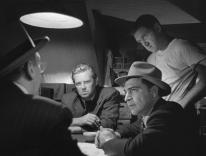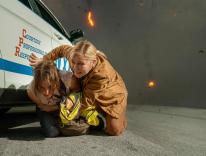Is there an actor working today who conveys a more mythically American presence than Tommy Lee Jones? His endlessly fascinating face unites opposites in our national character, making him both suave and brutal, calculating and homespun. He’s tough, but smart too (that Harvard education!), and while his characters generally play on the side of the angels, they don’t hesitate to get their hands dirty. Like Clint Eastwood, Jones is an avatar of gunslinger American manliness. Sure, he’s smiling, but you know what he could do to you if he let himself; and he knows you know. His steely, taunting grin hints at latent violence and a malicious pleasure in his own lethality.
In writer-director Paul Haggis’s In the Valley of Elah, that confident grin is gone, replaced by a harrowed visage of loss. Jones plays a retired military policeman named Hank Deerfield, whose two sons worshiped him and followed him into the military, with grievous results. At the film’s outset, Deerfield has already lost one to a helicopter training accident; and when he and his wife (Susan Sarandon) receive word their other son has gone AWOL while back from a tour of duty in Iraq, Deerfield drives out to a New Mexico Army base to untangle the mystery-which soon takes a gruesome turn when his son’s body is discovered, hacked and burned beyond recognition, in a field near the base.
In the Valley of Elah is nominally a police procedural, with Jones dusting off his old Army criminal investigation skills to join forces with Lt. Emily Sanders (Charlize Theron), a civilian police detective who smells a rat behind the military’s eagerness to take over the investigation. But the whodunit form is really beside the point, except insofar as it allows Haggis to calibrate the breakdown of Deerfield’s stoicism, the furrowing of yet another crease of misery in his deeply-lined face. What Haggis (whose last movie was the Oscar-winning Crash) is after is a certain type of American male patriotism, and what happens when it founders on a literally unspeakable loss.
Deerfield, we understand, is the prototype of the American who supports the troops and their mission because he believes in our national mission generally. He’s a workingman who lives in a modest neighborhood where every house flies the flag; who spit-shines his shoes every morning; who embarrassedly addresses a stripper in a dive where he’s investigating his son’s final hours as “ma’am.” Driv¬ing past a grade school he sees the flag flying upside down and stops to roust the school custodian and set things right. His patriotism, in other words, is deeply entwined with chivalry, stoical self-denial, and an unquestioning respect for authority. But as the horrific mystery of his son’s final hours unfolds, and he is stymied in his attempt to learn more, Deerfield lashes out in anger. “My son spent the last seventeen months bringing democracy to a shithole and serving his country,” he seethes to Theron. “He deserves better than this.”
I thought Crash was a bad movie, didactic behind its meretricious dazzle, burdened with self-congratulatory lectures on racism, garish plot manipulations, and a clumsy reach for allegory. Elah is a big improvement. It proceeds quietly, and for the most part Haggis lets his story’s meanings bubble upward from its materials, rather than manipulating them to make a point. He keeps the politics largely offstage. Yes, we hear George Bush droning on TV in the background, and a scene showing a flag-draped coffin reminds us how assiduously the White House has labored to keep this image of war’s cost off our TV screens. But the focus is on the far more general sorrow of losing a son to any war.
In the Valley of Elah lingers on the details of dread. In one early scene, an 8 a.m. knock at Hank’s motel door reveals a somber Army officer, and Hank retreats to the bathroom, ostensibly to stanch a nick he has inflicted on himself while shaving, but really to delay as long as possible the awful news he knows is coming. Equally gripping is the portrayal of what grief does to a marriage, as Sarandon explodes in recrimination, blaming Deerfield for pushing their son into the military. “Living in this house, he couldn’t feel like a man if he hadn’t gone,” she rages. “Both my boys-you could’ve left me one!” Roger Deakins’s cinematography has a bleached-out look, pale and ghostly; Charlize Theron wears severe gray blazers and her hair pulled back, as if in mourning; and Mark Isham’s Philip Glass-like score exudes somber gravity, lending a funereal air.
The movie ends badly, with a series of ugly revelations intended to drive home the savage desensitization of American soldiers in Iraq, and a closing symbolic gesture of almost incredible heavy-handedness. Some will insist that Haggis finally found his focus, that the film needed to be topical and polemical from the get-go. To me it felt as if he took a subtle, universal study of grief and turned it over to MoveOn.org.
Based on a Jon Krakauer book with the same title, Sean Penn’s Into the Wild tells the real-life story of Christopher McCandless, a college kid who, propelled by a mixture of grandiosity and grievance, decided to leave civilization and head out, alone and unaided, as far away as he could get-a tragedy that ended with his death at twenty-four, from starvation, in a remote reach of Alaska. The film alternates scenes from an abandoned bus where McCandless spent his last months, attempting to survive as a hunter-gatherer, with episodes from the preceding year and a half on the road, and cuts occasionally to his parents back East (William Hurt and Marcia Gay Harden), consumed by sorrow over their son’s disappearance.
Krakauer subsequently became famous for his chronicle of a doomed Everest expedition, Into Thin Air, and like that book, Into the Wild betrayed his fascination with the harshness of nature and those who risk their lives in it needlessly. Behind such risks Krakauer perceived a ferocious urge to seek ultimate answers, an intense asceticism, and a desert-father zeal for solitude in nature; his portrayal of McCandless combined Thoreau and St. John Chrysostom, with some Jack London thrown in for good measure.
The book walked a fine line between glorifying McCandless and acknowledging the dark, even pathological side of his isolation. Penn’s film walks the same tricky line, but less nimbly. Its look is exhilarated and glorious: majestic mountain panoramas, slo-mo shots in deep forests, and aerial plunges down river canyons. All suggest a commercial for the great outdoors, and overwhelm the more ambiguous human reality of the story. Penn emphasizes his hero’s passionate idealism, but what I kept seeing was the sullen revenge of an adolescent who blames his parents’ hypocrisy for everything that’s wrong with the world, and whose fate bespeaks not tragic grandeur, but peevishness and naiveté. As it turned out, McCandless’s death was needless. He never discovered a nearby shelter stocked with emergency supplies, leading an Anchorage newspaper to observe that “many Alaskans react with rage to his stupidity.”
By far the best parts of the movie are the on-the-road segments, a picaresque narrative of encounters with various friendly strangers McCandless meets along his way: a boisterous wheat farmer (Vince Vaughan), an aging hippie (Catherine Keener), and a widowed retiree with a sorrowful past (Hal Holbrook). These vignettes elicit superlative performances by the other actors, as surrogate parents who enjoy the young man’s buoyant company (he’s played by a sweet-smiling young actor, Emile Hirsch) and worry about the journey he is on. Each of them gently counsels McCandless to grow up, reminding him that the love and company of others is life’s great consolation, and warning him about the oblivion he is headed toward.
If only he had listened.
Please email comments to [email protected] and join the conversation on our Facebook page.
Previous Story
New Century, Same Crisis
Next Story
Bringing Out the Dead


